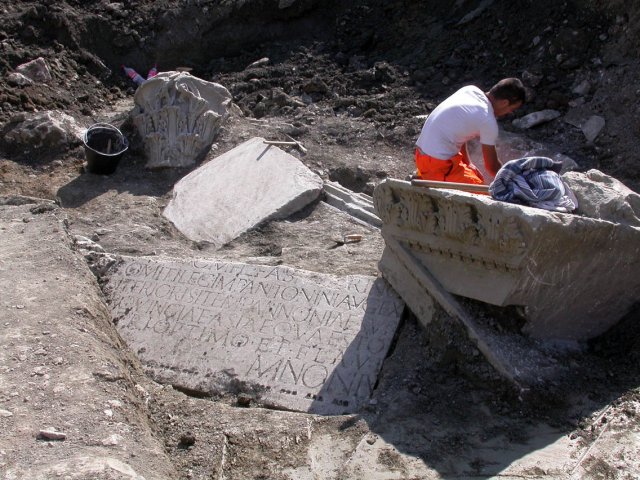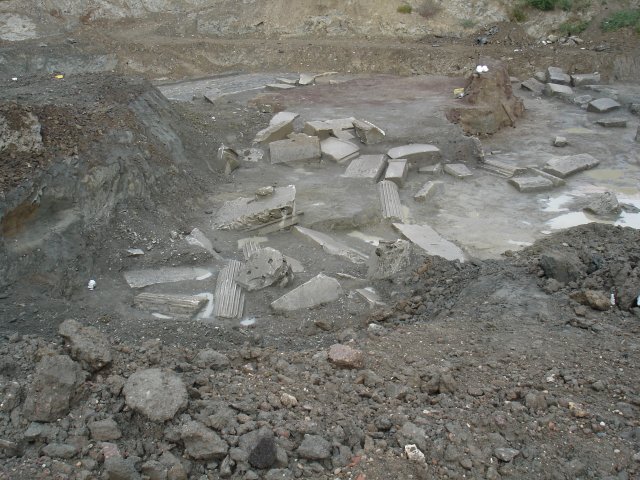








|
|
Monument to 'Gladiator' found on the Via Flaminia
october 16th, 2008
The biggest and, for some aspects, astonishing findings are the perfectly preserved marbles of a huge burial monument probably hidden by a flooding. For this reason archeologists think that the monument is just to be re-assembled because all the capitols, columns and walls are just fallen into the mug of the flooding. But this is not the only surprise: from the epigraphs archeologists have discovered that the
monument was dedicated to Marcus Nonius Macrinus one of the most famous and powerful roman family during the II century A.D.
 The epigraph.
The epigraph.
© Photo Ministero dei Beni e delle Attività Culturali. Uso concesso a corredo della notizia.
"Concerning the true Marcus Nonius Macrinus, we know plenty about his military career – Daniela Rossi, the archeologist with Italy's Culture Ministry who reported this week's finding, says more than ten inscriptions have been found recording his triumphs, the fullest one to date being from Ephesus and in the Greek language – but tantalisingly little about what made him tick. He came from Brixia, nowaday Brescia, in northern Italy, where his was one of the most important families, he began his military career under Aurelius's predecessor Antoninus Pius, and fought valiantly and successfully against the Quadi and the Marcommani, the Germanic tribes which had crossed the Danube and were set on invading Italy.
Two years ago the remains of a great villa were discovered on the shores of Lake Garda, not far from the modern city of Brescia where the Fabia tribe to which his family belonged were the rulers. Here Macrinus lived with his wife Arria, who was from the Etruscan Arri tribe.
What is certain is that Macrinus was one of the most important figures of his age and an intimate friend of the emperor. Doubtless he was one of the men on whom Aurelius most depended for the safety of the empire while he was ordering the construction of beautiful monuments and thinking great thoughts back in Rome. When Aurelius's brother Verus, with whom he had ruled jointly, died in battle, Macrinus was "chosen out of the closest friends", in the general's own words, to be a priest in the cult of the new Roman god Divus Verus, the deified spirit of the dead brother.
And when Macrinus died his son erected this magnificent tomb for him between the River Tiber and the Via Flaminia, the road leading north-east across the Appenines to the modern seaside resort of Rimini which Macrinus must have taken many times on his way to confront the Quadi and the Marcommani. Eight and a half kilometres from the city walls, it was in an area where his Fabia tribe had become important landowners.
This figure inspired Ridley Scott in his famous movie Gladiator (2000), even if the name was changed into Maximus and interpreted by Russel Crowe.


Left: The uncovered ancient Via Flaminia. Right: the complete sight of the excavations
© Photo Ministero dei Beni e delle Attività Culturali. Uso concesso a corredo della notizia.
Professor Rossi calls the find "the most important ancient Roman monument to come to light in the suburbs of Rome for many years," and she and her ten colleagues in the dig are now working against the clock to find what else is down there, stuck in the ancient mud which settled over the tomb once the flood had done its devastating work.
Today, as it has been unearthed over recent months by the archeolgists, the tomb looks much as it must have done when the Tiber's flash flood wreaked havoc on it, smashing walls and columns and pediments and caking the resulting mess in a coat of lime
"The tomb was destroyed by the river, perhaps by a sudden flood," said Professor Rossi. "We have only just begun to find how much is down there, so it is too early to say what form the tomb took, whether it was a single structure or two or several: much of it remains buried in mud; perhaps we will also find the sarcophagus. It's also too early to say how big it is, but it appears there was a row of columns at least 15 metres long, so it was quite huge."
When and how did Marcus Nonius Macrinus die? "We really don't know," admits Professor Rossi, "but if we succeed in finding the other two parts of the broken inscription, perhaps we will find out."
The current project is to recover all the findings in the area and rebuild the monument into a museum possibly in the same location.
Click to enlarge map

|
|
|